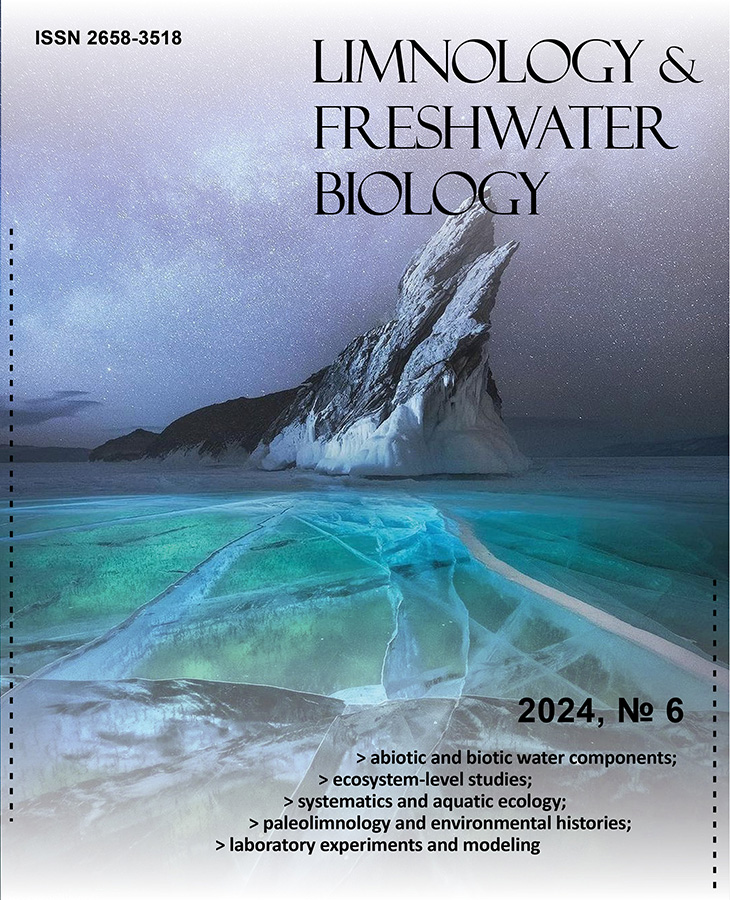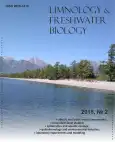The effects of sound pollution as a stress factor for the Baikal coregonid fish
- Авторы: Sapozhnikova Y.P.1, Gasarov P.V.2, Makarov M.M.1, Kulikov V.A.3,4, Yakhnenko V.M.1, Glyzina O.Y.1, Tyagun M.L.1, Belkova N.L.1, Wanzenböck J.5, Sullip M.K.6, Sukhanova L.V.1
-
Учреждения:
- Limnological Institute, Siberian Branch of the Russian Academy of Sciences
- Irkutsk State University
- Skolkovo Institute of Science and Technology
- Institute of Automation and Electrometry, Siberian Branch of the Russian Academy of Sciences
- University of Innsbruck
- ICAR-National Bureau of Fish Genetic Resources
- Выпуск: № 2 (2018)
- Страницы: 135-140
- Раздел: Статьи
- URL: https://journal-vniispk.ru/2658-3518/article/view/284256
- DOI: https://doi.org/10.31951/2658-3518-2018-A-2-135
- ID: 284256
Цитировать
Полный текст
Аннотация
We have studied morphological features of the hearing epithelium affected and unaffected by increased long-term sound (at 160 dB re 1 μPa) on the example of the Baikal omul (Coregonidae, Coregonus migratorius). The sensory epithelium was analyzed using the 3D confocal laser scanning techniques. We observed local epithelium damages in the rostral, central and caudal regions of the saccule, e.g. sticking stereocilia, vacuolization and round shape gaps. This article discusses the reasons for the local effects of sound on different regions of the sensory epithelium. We assume that using of morphological screening of sensory acoustic system in the artificial rearing of the Baikal coregonid fishes under the conditions of intense noise could contribute to indicating the most stress-resistant forms, which are promising for high-tech industrial aquaculture, and developing more gentle approaches to its creation.
Ключевые слова
Об авторах
Yu. Sapozhnikova
Limnological Institute, Siberian Branch of the Russian Academy of Sciences
Автор, ответственный за переписку.
Email: jsap@mail.ru
Россия, Ulan-Batorskaya Str., 3, Irkutsk, 664033
P. Gasarov
Irkutsk State University
Email: jsap@mail.ru
Россия, Irkutsk 664003
M. Makarov
Limnological Institute, Siberian Branch of the Russian Academy of Sciences
Email: jsap@mail.ru
Россия, Ulan-Batorskaya Str., 3, Irkutsk, 664033
V. Kulikov
Skolkovo Institute of Science and Technology; Institute of Automation and Electrometry, Siberian Branch of the Russian Academy of Sciences
Email: jsap@mail.ru
Россия, Moscow 143026; Novosibirsk 630090
V. Yakhnenko
Limnological Institute, Siberian Branch of the Russian Academy of Sciences
Email: jsap@mail.ru
Россия, Ulan-Batorskaya Str., 3, Irkutsk, 664033
O. Glyzina
Limnological Institute, Siberian Branch of the Russian Academy of Sciences
Email: jsap@mail.ru
Россия, Ulan-Batorskaya Str., 3, Irkutsk, 664033
M. Tyagun
Limnological Institute, Siberian Branch of the Russian Academy of Sciences
Email: jsap@mail.ru
Россия, Ulan-Batorskaya Str., 3, Irkutsk, 664033
N. Belkova
Limnological Institute, Siberian Branch of the Russian Academy of Sciences
Email: jsap@mail.ru
ORCID iD: 0000-0001-9720-068X
Россия, Ulan-Batorskaya Str., 3, Irkutsk, 664033
Jo. Wanzenböck
University of Innsbruck
Email: jsap@mail.ru
Research Institute for Limnology Mondsee
Австрия, A-5310 MondseeM. Sullip
ICAR-National Bureau of Fish Genetic Resources
Email: jsap@mail.ru
Индия, Telibagh, Lucknow 226 002
L. Sukhanova
Limnological Institute, Siberian Branch of the Russian Academy of Sciences
Email: jsap@mail.ru
Россия, Ulan-Batorskaya Str., 3, Irkutsk, 664033
Список литературы
- Amoser S., Wysocki L.E., Ladich F. 2004. Noise emission during the first powerboat race in an Alpine lake and potential impact on fish communities. Journal of the Acoustical Society of America 116: 3789–3797. doi: 10.1121/1.1808219
- Bradbury J.W., Vehrencamp S.L. 2011. Principles of animal communication. 2nd Edn. Sunderland: Sinauer Associates Inc. Publishers.
- Caiger P.E., Montgomery Jo.C., Radford C.A. 2012. Chronic low-intensity noise exposure affects the hearing thresholds of juvenile snapper. Marine Ecology Progress Series 466: 225–232. doi: 10.3354/meps09933
- Engas A., Lokkeborg S., Ona E. et al. 1996. Effects of seismic shooting on local abundance and catch rates of cod (Gadus Morhua) and haddock (Melanogrammus aeglefinus). Canadian Journal of Fisheries and Aquatic Sciences 53: 2238–2249. doi: 10.1139/f96-177
- Glotin H., Poupard M., Marxer R. et al. 2017. Big data passive acoustic for Baikal Lake soundscape and ecosystem observatory [B2O]. Toulon: DYNI CNRS LSIS team. (in Russian)
- Hastings M.C., Popper A.N., Finneran J.J. et al. 1996. Effect of low frequency underwater sound on hair cells of the inner ear and lateral line of the teleost fish Astronotus ocellatus. Journal of the Acoustical Society of America 99: 1759–1766. doi: 10.1121/1.414699
- Hawkins A.D., Sand O. 1977. Directional hearing in the median vertical plane by the cod. Journal of Comparative Physiology A 122: 1–8. doi: 10.1007/BF00611244
- Hawkins A., Roberts L., Cheesman S. 2014. Responses of free-living coastal pelagic fish to impulsive sounds. Journal of the Acoustical Society of America 135: 3101–3116. doi: 10.1121/1.4870697
- Hughes A.R., Mann D.A., Kimbro D.L. 2014. Predatory fish sounds can alter crab foraging behavior and influence bivalve abundance. Proceedings of the Royal Society B 281. doi: 10.1098/rspb.2014.0715
- Klimenkov I.V., Sudakov N.P., Pastukhov M.V. et al. 2018. Rearrangement of actin microfilaments in the development of olfactory receptor cells in fish. Scientific Reports 8. DOI: 0.1038/s41598-018-22049-7
- Kulikov V.A., Sapozhnikova Yu.P., Kirilchik S.V. et al. 2014. Algorithms for quantitative analysis of the behavior of the Baikal omul under experimental conditions. In: V All-Russian Conference Fish Behavior, pp. 131–136. (in Russian)
- Ladich F. 2013. Effects of noise on sound detection and acoustic communication in fishes. In: Brumm H. (Ed.), Animal communication and noise. Berlin: Springer, pp. 65–90.
- Ladich F., Schulz-Mirbach T. 2016. Diversity in fish auditory systems: one of the riddles of sensory biology. Frontiers in Ecology and Evolution 4. doi: 10.3389/fevo.2016.00028
- Lu Z., Xu Z. 2002. Effects of saccular otolith removal on hearing sensitivity of the sleeper goby (Dormitator latifrons). Journal of Comparative Physiology A 188: 595–602. doi: 10.1007/s00359-002-0334-6
- Mikodina E.V., Sedova M.A., Pyanova S.V. et al. 2011. Aquaculture. Issue 6. Guidance on the use of an anesthetic “clove oil” in aquaculture. Moscow: VNIRO Publishing House. (in Russian)
- Montgomery J.C., Jeffs A.G., Simpson S.D. et al. 2006. Sound as an orientation cue for the pelagic larvae of reef fishes and decapod crustaceans. Advances in Marine Biology 51: 143–196. doi: 10.1016/S0065-2881(06)51003-X
- Platt C., Popper A.N. 1981. Fine structure of the ear. Hearing and sound communication in fishes. New York: Springer-Verlag, pp. 3–38.
- Popper A.N. 2011. Auditory system morphology. In: Farrell A.P. (Ed.), Encyclopedia of fish physiology: from genome to environment. Amsterdam: Academic Press, pp. 252–261.
- Popper A.N., Coombs S. 1982. The morphology and evolution of the ear in actinopterygian fishes. American Zoologist 22: 138–143.
- Popper A.N., Fay R.R. 1999. The auditory periphery in fishes. In: Fay R.R., Popper A.N. (Eds.), Comparative hearing: fish and amphibians. New York: Springer Verlag, pp. 43–100.
- Popper A.N., Hastings M.C. 2009. The effects of anthropogenic sources of sound on fishes. Journal of Fish Biology 75: 455–489.doi: 10.1111/j.1095-8649.2009.02319.
- Popper A.N., Ramcharitar J., Campana S.E. 2005. Why Otoliths? Insights from inner ear physiology and fisheries biology. Marine and Freshwater Research 56: 497–504. doi: 10.1071/MF04267
- Sapozhnikova Yu.P. 2018. Fish hearing. Science First Hand 80: 80–91. (in Russian)
- Sapozhnikova Yu.P., Belous A.A., Makarov M.M. et al. 2017. Ultrastructural correlates of acoustic sensitivity in Baikal coregonid fishes. Fundamental and Applied Limnology 189: 267–278. doi: 10.1127/fal/2017/0810
- Sapozhnikova Yu.P., Klimenkov I.V., Khanaev I.V. et al. 2016. Ultrastructure of saccular epithelium sensory cells of four sculpin species (Cottoidei) of Lake Baikal in relation to their way of life. Journal of Ichthyology 56: 289–297. doi: 10.1134/S0032945216010136
- Schuijf A., Hawkins A.D. 1976. Sound reception in fish. Amsterdam, Oxford, New York: Elsevier Scientific Publishing Company.
- Smirnov V.V., Smirnova-Zalumi N.S., Sukhanova L.V. 2009. Microevolution of Baikal omul: Coregonus autumnalis migratorius (Georgi). Novosibirsk: Publishing House of the SB RAS. (in Russian)
- Smith M.E., Schuck J.B., Gilley R.R. et al. 2011. Structural and functional effects of acoustic exposure in goldfish: evidence for tonotopy in the teleost saccule. BMC Neuroscience 12: 1–16. doi: 10.1186/1471-2202-12-19
- Sukhanova L., Politov D., Wanzenbock Jo. et al. 2017. Biology and management of Coregonid fishes. Fundamental and Applied Limnology 189: 177–179. doi: 10.1127/fal/2017/1028
- Tallman R.F., Reist J.D. 1997. Information requirements for fishery management and overview of scientific approach. Canadian Technical Report of Fisheries and Aquatic Sciences 2193: 53–62.
- Voellmy I.K., Purser J., Simpson S.D. et al. 2014. Increased noise levels have different impacts on the antipredator behavior of two sympatric fish species. PLoS ONE 9: e102946. doi: 10.1371/journal.pone.0102946
- Wysocki L.E., Davidson III J.W., Smith M.E. et al. 2007. Effects of aquaculture production noise on hearing, growth, and disease resistance of rainbow trout Oncorhynchus mykiss. Aquaculture 272: 687–697. doi: 10.1016/j.aquaculture.2007.07.225
- Zhongmin L., Xu Z. 2002. Effects of saccular otolith removal on hearing sensitivity of the sleeper goby (Dormitator latifrons). Journal of Comparative Physiology 188: 595–602. doi: 10.1007/s00359-002-0334-6
Дополнительные файлы










